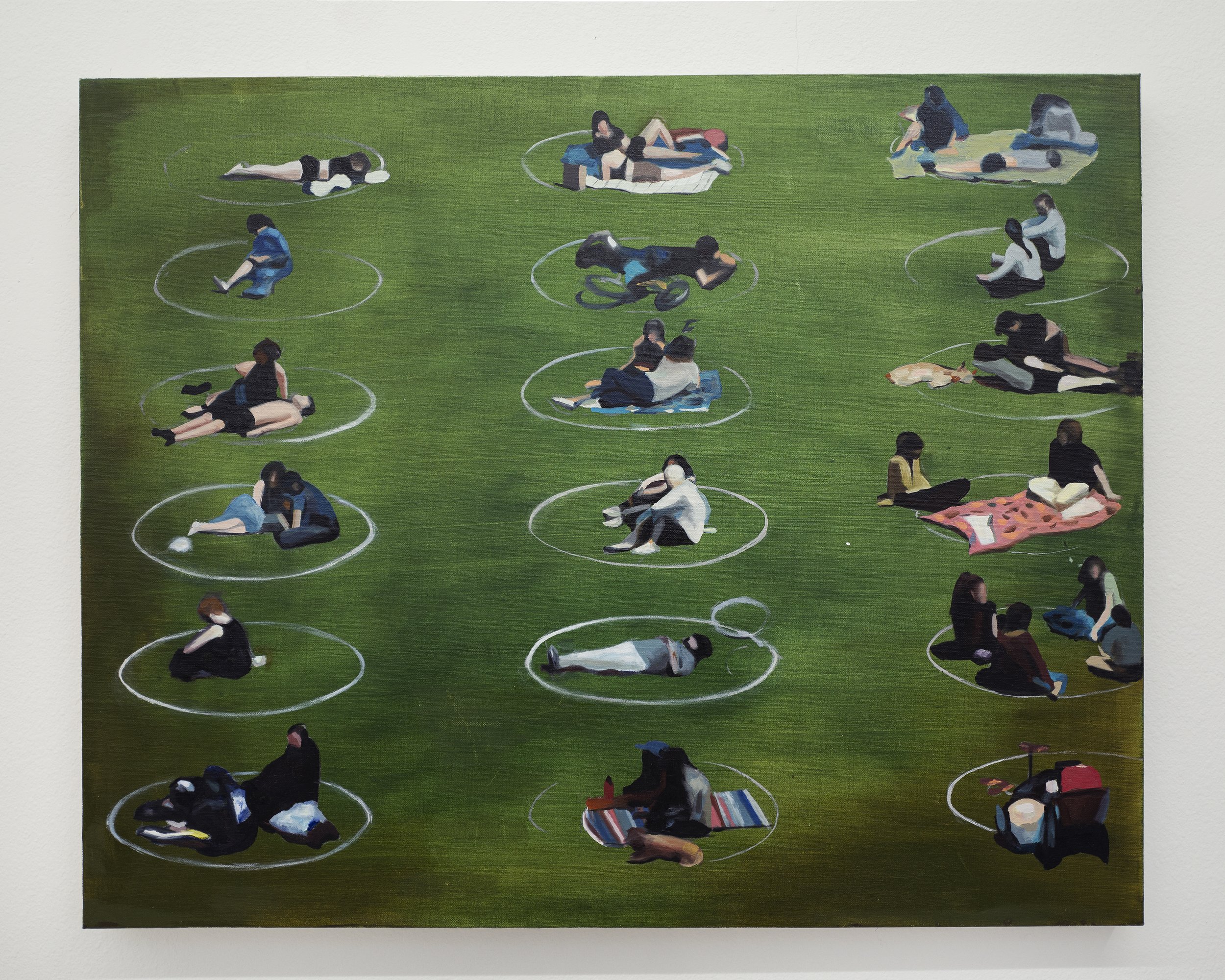A Sunday Afternoon in the Park, 2022
A Sunday Afternoon in the Park, 2022
Oil on linen
61 x 76 cm (24 x 30 in)
A Sunday Afternoon in the Park (2022) engages with the utopic ideologies of control and function, reflecting on the challenges of navigating daily life and social interactions amidst the ongoing COVID-19 pandemic. The piece draws inspiration from an archival photograph, Tan Mu subtly documents the nuances of living in New York City during such a unique moment in history. The painting portrays a grid-like arrangement, where a crowd of individuals occupies the park, spaced equally within geometric, contained zones. These boundaries, which have become common in urban settings, create a sense of order amid the chaos of the pandemic. At the center of the composition, a woman is depicted facing forward, her face concealed by a white mask. The work ultimately reflects the mechanisms of urban design that regulate the movement and interaction of individuals, revealing the tension between public health protocols and the persistence of everyday life.
Q: What inspired you to create A Sunday Afternoon in the Park?
Tan Mu: The piece draws inspiration from a photograph captured by Johannes Eisele on May 17th, 2020, in Domino Park, New York City, which appeared in CNN's article "Domino Park circles keep New York City Sunbathers in check." The title of the work deliberately echoes Georges Seurat’s A Sunday Afternoon on the Island of La Grande Jatte, juxtaposing a serene outdoor scene with the stark realities of the pandemic. This image resonated with me as a visual representation of pandemic life: the juxtaposition of longing for social connection and nature against the constraints of public health measures. People appeared scattered in small groups, cycling, picnicking, or walking their pets, but each activity was confined within neatly painted white circles on the grass. The scene evoked a peculiar mix of familiarity and estrangement—an ordinary afternoon in the park disrupted by extraordinary circumstances. This contrast inspired the piece, capturing the tension between leisure and restriction that defined this unprecedented moment in time.
Q: What visual language did you use to express this moment?
Tan Mu: In this piece, I used bold brushstrokes to create the background, capturing the open grass of the park. The three rows of circles are placed in a way that emphasizes the contrasting relationship between public space and individual separation, highlighting the imposed order in a public park during the pandemic. The focus is on a single circle in the center, where a figure wearing a white mask stands, symbolizing the impact of the pandemic on daily life. The figure gazes toward the viewer as if engaging in a dialogue with the outside world. Within the circle, each person is depicted enjoying the weekend in familiar ways—some are conversing, others are exercising, and a few are sunbathing or meditating. However, the circle serves as a boundary, isolating each individual and creating a new, enforced order that contrasts with the freedom typically found in a public park. This visual language communicates the tension between personal space and social restrictions during the pandemic, capturing both the continuity of leisure and the disruption of normalcy.
Q: How has your personal experience of isolation during the pandemic influenced the themes and execution of works?
Tan Mu: In March 2020, during the COVID-19 lockdown, I began painting at home, as social distancing limited physical touch and communication shifted online. This environment of isolation and disconnection prompted me to reflect on these phenomena and their impact on human connection. Throughout this period, I created several works exploring personal, social, technological, and public health-related themes. These included pieces like Philadelphia (2020), Minneapolis (2020), Thermal Imaging (2022), and Touch (2022), which examine social events and the role of technology, as well as works like Isolation (2020), A Sunday Afternoon in the Park (2022) and Yoga Isolation (2022), which reflect on public spaces and the routines we adapted to during lockdown. I also explored the breakthroughs of medical technologies such as vaccines in vaccine (2021). These works allowed me to reflect on and document the era we were living through, while also offering a way of expressing my creative drive rooted in love and humanity. Through detailed, multidimensional depictions of these themes, I hope to evoke a sense of both connection and disconnection in my audience. This approach to exploring the pandemic period mirrors my broader artistic practice, which seeks to record and comment on significant moments in history, whether through technology, events, or everyday life.



